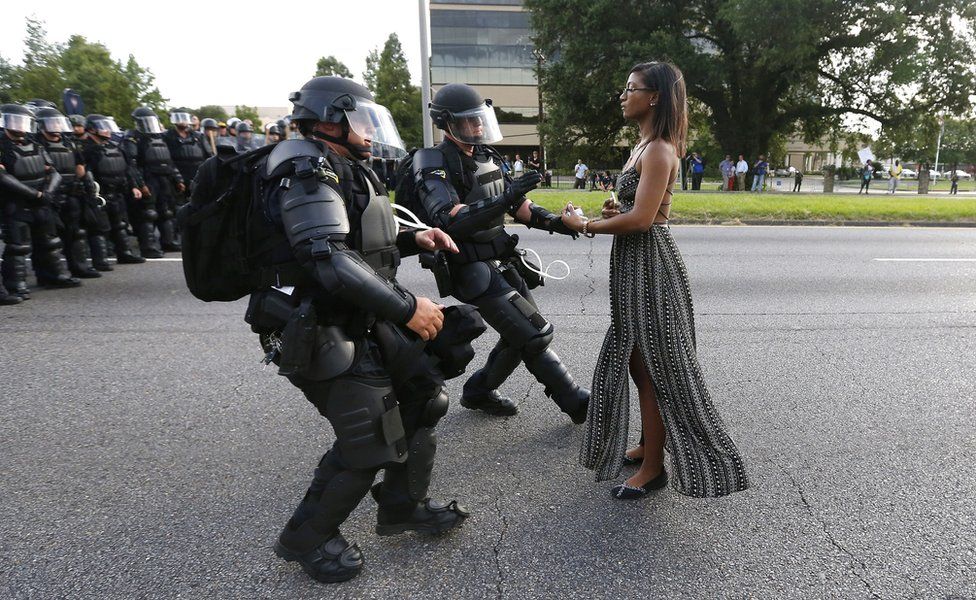MEDIA RANTS
Still Photos After All These Years
By Tony Palmeri
What medium best captures the essence of an event or
even an entire movement? In a YouTube era that gives us all the chance to go
“viral” with our amateur films, it’s tempting to give the nod to privately made
moving images. Indeed the amateurish, grainy cell phone video in the 21st
century seemingly has the power to define moments in ways that the more slickly
produced establishment newspapers, television, radio, and Hollywood films never
could. The fact that the YouTuber, or the live Facebooker, or some other
multimedia video maker generally doesn’t seek monetary profit gives their
creation a kind of authenticity and credibility no longer enjoyed by the greedy
corporate media. Writing for Time.com, Daniel D’Addario argues that the
disturbing Facebook live video of Diamond Reynolds narrating the police murder
of her boyfriend Philando Castile in Falcon Heights, MN may “change how we
experience news” and is a “defining testament of how we live now.”
But just because amateur moving images are
pervasive, often powerful, and perceived as credible does not mean they best
capture the essence of events or movements. That essence, I would argue, is
captured more provocatively by a much older art form: the still photo. The best
recent example is freelance photographer Jonathan Bachman’s photo of
35-year-old Ieshia L. Evans, a nurse and mother who calmly yet assertively
confronted Baton Rouge riot police during a protest of the police killing of
Alton Sterling. The photo, which is simultaneously inspiring and terrifying in
its display of an unarmed African-American woman in a sun dress preparing to be
arrested by officers dressed in full occupying force gear, will many years from
now be seen as a profound example of how the militarization of America’s local
police forces played a key role in the creation of #BlackLivesMatter and other
resistance movements.
After the photo went viral, Ms. Evans issued a
statement: "When the police pushed everyone
off the street, I felt like they were pushing us to the side to silence our
voices and diminish our presence. They were once again leveraging their
strength to leave us powerless. As Africans in America we're tired of
protesting that our lives matter, it's time we stop begging for justice and
take a stance for our people. It's time for us to be fearless and take our
power back." [Note: In virtually every online story about Ms. Evans, the comments sections features a slew of fiercely racist remarks that in their ignorance end up proving what #BlackLivesMatter and other activists have been saying about race in America.].
Some observers referred to the photo of Ms. Evans as
“iconic,” and I would agree. Visual rhetoric scholars John Lucaites and Robert Hariman defined iconic photographs: “photographic images produced in print,
electronic, or digital media that are (1) recognized by everyone within a
public culture, (2) understood to be representations of historically
significant events, (3) objects of strong emotional identification and
response, and (4) regularly reproduced or copied across a range of media,
genres, and topics.” The authors analyze a number of iconic photos including
Joe Rosenthal’s raising of the flag on Iwo Jima (taken in 1945), John Filo’s1970 capture of the tragic killing of a
student by the National Guard at Kent State, Nick Ut’s 1972 Vietnam War photo of the “napalm girl” fleeing the American assault on her village, and Jeff Widener’s 1989 Tiananmen Square photo of a
single protester in China going up against a tank. Each one of these photos not only captured the essence of the historical moment in question, but also provoked necessary conversations about
America’s commitment to democracy
and human rights. Go to the website readingthepictures.org to see Lucaites’ and
Hariman’s (and other writers’) takes on a wide range of contemporary and older
photos.
student by the National Guard at Kent State, Nick Ut’s 1972 Vietnam War photo of the “napalm girl” fleeing the American assault on her village, and Jeff Widener’s 1989 Tiananmen Square photo of a
single protester in China going up against a tank. Each one of these photos not only captured the essence of the historical moment in question, but also provoked necessary conversations about
The 2016 summer Olympics in Brazil reminds me
of my all-time favorite iconic photo: John Dominis’ brilliant capture of USA
track and field medalists Tommie Smith and John Carlos defiantly engaged in the
Black Power salute at the 1968 games in Mexico City. The athletes’ action and
the photograph of it occurred in the context of the Cold War in which the
United States promoted itself as the land of freedom and equality in contrast
to the oppressive Soviet Union. Smith and Carlos blew up the USA image, in the
process getting themselves suspended from the games.
John Carlos recently reflected on his Olympic activism for vox.com. Even though the aftermath was “hell” for him and his family, Carlos expresses no regrets. In fact he urges contemporary Black athletes and celebrities to be activists. Of the iconic photo he says this:
“That picture of me and Tommie on
the podium is the modern-day Mona Lisa — a universal image that everyone wants
to see and everyone wants to be related to in one way or another. And do you
know why? Because we were standing for something. We were standing for
humanity.”
If John Carlos is correct, it
suggests that Ieshia Evans’ photo will be featured in books, documentaries, and
other media for many years to come.
Photographer Sally Mann once said that “Photographs open doors into the
past, but they also allow a look into the future.” The beauty of the iconic
photo is that it provokes wide ranging conversation about the past and future.
When we look at John Carlos in 1968 we can see Ieshia Evans in 2016 and vice
versa. Will the photos motivate us to create a better future? Time will tell.





